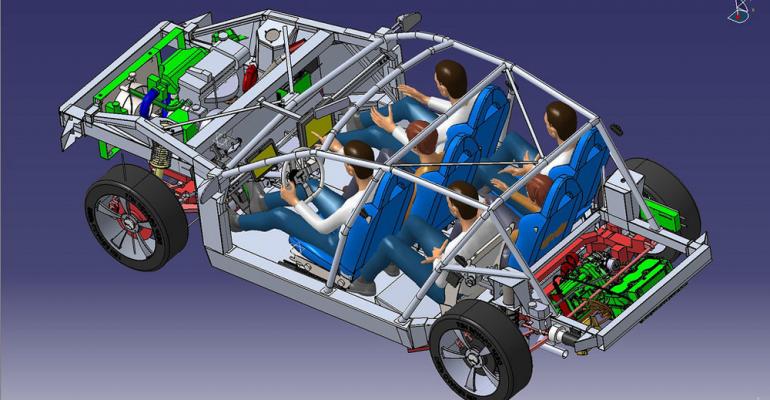TRAVERSE CITY, MI – The globalization of the American auto industry is nowhere more obvious than in the NBT, or the Next Big Thing, the third-generation prototype car made by students at the Clemson University International Center for Automotive Research.
Wheras the first two student projects involved transforming the BMW 1-Series’ powertrain and interior, the third project is a ground-up new car, sponsored by Mazda and developed in the CU-ICAR engineering center in Greenville, SC, next to BMW and Michelin, two of the leading European automotive brands.
The NBT was displayed in its body-in-white form at last year’s Specialty Equipment Market Assn., showing off the body components made of folded sheet metal. On display here at the CAR Management Briefing Seminars, it has its skin, designed by Fred Naaman, who will graduate from Art Center College of Design in Pasadena, CA, at the end of the year.
The car is 483 ins. (190 cm wide) and about as long as the Mazda3, says Naaman. The middle seats can fold up to become cupholders if there are only four passengers.
This year’s prototype project started two years ago with marketing research aimed at finding out the kind of a car on which Generation Y would spend money. As most of Gen Y doesn’t care about cars, “we concentrated on the small segment that does like them,” says Chris LaMance, who worked on several parts of the car and was project manager for the tubular spaceframe.
The car has three bucket seats in front and in back, because market research shows Gen Y wants five or more seats. It makes sense, because Gen Y is social. “They don’t want to be in the car with one other person. They want to be with their friends,” he says.
The tubular spaceframe is welded to a floorpan made with folded, riveted and glued sheetmetal from Industrial Origami, a company promoting this alternative to stampings. “We folded the metal ourselves in our lab,” says LaMance, who now works for Honda Mfg. in Alabama.
The student engineers designed the parts they needed and ordered flat sheet metal trimmed to the right size that they folded with the help of homemade jigs and Industrial Origami system that permits precision.
The concept car has not gone through virtual crash-testing, so the claimed advantage of the system for light-weighting a vehicle is just that. Still, the mass of the vehicle is part of the hybrid’s claimed 45 mpg (5.2 L/100 km) fuel economy.
When the sedan’s doors are open, the six bucket seats, tubular spaceframe and floorpan are visible. But closed, the vehicle has a finished concept car look developed by Naaman and his Mazda Design coaches.
The design goal was to make a car with the Mazda ZoomZoom DNA and have the look of a car more expensive than it would be, he says, noting a Gen Y buyer at about age 26 could lease such a car for an estimated $400 a month.
BMW is the sponsor of next year’s project, a derivative of the X3 that will be displayed at SEMA. General Motors is next in line, with students working on a small urban car that Gen Z (those born in the late 1990s) would want in 2020.





